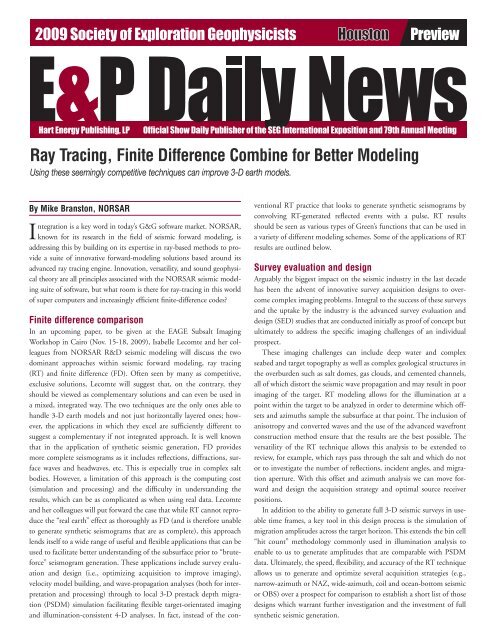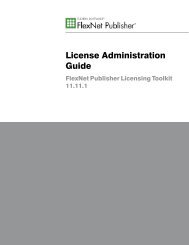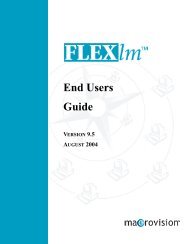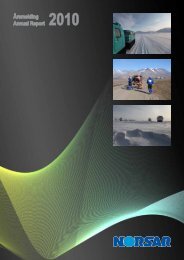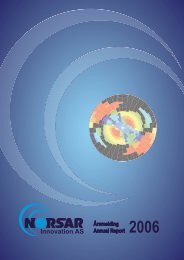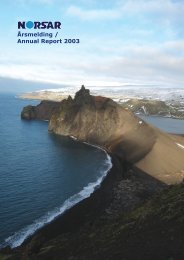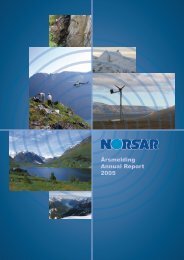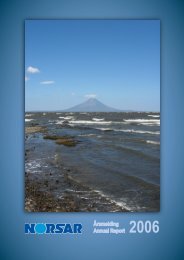SEG-RayTrace:Layout 1 - norsar
SEG-RayTrace:Layout 1 - norsar
SEG-RayTrace:Layout 1 - norsar
Create successful ePaper yourself
Turn your PDF publications into a flip-book with our unique Google optimized e-Paper software.
2009 Society of Exploration Geophysicists Houston Preview<br />
Hart Energy Publishing, LP Official Show Daily Publisher of the <strong>SEG</strong> International Exposition and 79th Annual Meeting<br />
Ray Tracing, Finite Difference Combine for Better Modeling<br />
Using these seemingly competitive techniques can improve 3-D earth models.<br />
By Mike Branston, NORSAR<br />
Integration is a key word in today’s G&G software market. NORSAR,<br />
known for its research in the field of seismic forward modeling, is<br />
addressing this by building on its expertise in ray-based methods to provide<br />
a suite of innovative forward-modeling solutions based around its<br />
advanced ray tracing engine. Innovation, versatility, and sound geophysical<br />
theory are all principles associated with the NORSAR seismic modeling<br />
suite of software, but what room is there for ray-tracing in this world<br />
of super computers and increasingly efficient finite-difference codes?<br />
Finite difference comparison<br />
In an upcoming paper, to be given at the EAGE Subsalt Imaging<br />
Workshop in Cairo (Nov. 15-18, 2009), Isabelle Lecomte and her colleagues<br />
from NORSAR R&D seismic modeling will discuss the two<br />
dominant approaches within seismic forward modeling, ray tracing<br />
(RT) and finite difference (FD). Often seen by many as competitive,<br />
exclusive solutions, Lecomte will suggest that, on the contrary, they<br />
should be viewed as complementary solutions and can even be used in<br />
a mixed, integrated way. The two techniques are the only ones able to<br />
handle 3-D earth models and not just horizontally layered ones; however,<br />
the applications in which they excel are sufficiently different to<br />
suggest a complementary if not integrated approach. It is well known<br />
that in the application of synthetic seismic generation, FD provides<br />
more complete seismograms as it includes reflections, diffractions, surface<br />
waves and headwaves, etc. This is especially true in complex salt<br />
bodies. However, a limitation of this approach is the computing cost<br />
(simulation and processing) and the difficulty in understanding the<br />
results, which can be as complicated as when using real data. Lecomte<br />
and her colleagues will put forward the case that while RT cannot reproduce<br />
the “real earth” effect as thoroughly as FD (and is therefore unable<br />
to generate synthetic seismograms that are as complete), this approach<br />
lends itself to a wide range of useful and flexible applications that can be<br />
used to facilitate better understanding of the subsurface prior to “bruteforce”<br />
seismogram generation. These applications include survey evaluation<br />
and design (i.e., optimizing acquisition to improve imaging),<br />
velocity model building, and wave-propagation analyses (both for interpretation<br />
and processing) through to local 3-D prestack depth migration<br />
(PSDM) simulation facilitating flexible target-orientated imaging<br />
and illumination-consistent 4-D analyses. In fact, instead of the con-<br />
ventional RT practice that looks to generate synthetic seismograms by<br />
convolving RT-generated reflected events with a pulse, RT results<br />
should be seen as various types of Green’s functions that can be used in<br />
a variety of different modeling schemes. Some of the applications of RT<br />
results are outlined below.<br />
Survey evaluation and design<br />
Arguably the biggest impact on the seismic industry in the last decade<br />
has been the advent of innovative survey acquisition designs to overcome<br />
complex imaging problems. Integral to the success of these surveys<br />
and the uptake by the industry is the advanced survey evaluation and<br />
design (SED) studies that are conducted initially as proof of concept but<br />
ultimately to address the specific imaging challenges of an individual<br />
prospect.<br />
These imaging challenges can include deep water and complex<br />
seabed and target topography as well as complex geological structures in<br />
the overburden such as salt domes, gas clouds, and cemented channels,<br />
all of which distort the seismic wave propagation and may result in poor<br />
imaging of the target. RT modeling allows for the illumination at a<br />
point within the target to be analyzed in order to determine which offsets<br />
and azimuths sample the subsurface at that point. The inclusion of<br />
anisotropy and converted waves and the use of the advanced wavefront<br />
construction method ensure that the results are the best possible. The<br />
versatility of the RT technique allows this analysis to be extended to<br />
review, for example, which rays pass through the salt and which do not<br />
or to investigate the number of reflections, incident angles, and migration<br />
aperture. With this offset and azimuth analysis we can move forward<br />
and design the acquisition strategy and optimal source receiver<br />
positions.<br />
In addition to the ability to generate full 3-D seismic surveys in useable<br />
time frames, a key tool in this design process is the simulation of<br />
migration amplitudes across the target horizon. This extends the bin cell<br />
“hit count” methodology commonly used in illumination analysis to<br />
enable to us to generate amplitudes that are comparable with PSDM<br />
data. Ultimately, the speed, flexibility, and accuracy of the RT technique<br />
allows us to generate and optimize several acquisition strategies (e.g.,<br />
narrow-azimuth or NAZ, wide-azimuth, coil and ocean-bottom seismic<br />
or OBS) over a prospect for comparison to establish a short list of those<br />
designs which warrant further investigation and the investment of full<br />
synthetic seismic generation.
PSDM simulation<br />
Ordinarily the next step with the<br />
SED process would be to generate<br />
a full synthetic dataset for the<br />
shortlisted acquisition strategies.<br />
However, recent advances in the<br />
application of the RT method<br />
mean that it is now possible to<br />
accurately simulate 3-D PSDM<br />
data cubes for local targets of interest<br />
within the subsurface. The<br />
patented SimPLI concept, developed<br />
by NORSAR, efficiently estimates<br />
PSDM seismic cubes<br />
without the need to predict and<br />
process synthetic seismic gathers.<br />
The method can be regarded as a<br />
generalized 3-D convolution technique<br />
working in the depth<br />
domain constrained by 3-D illumination<br />
and resolution effects of the<br />
acquisition and overburden. As<br />
such, it goes far beyond classic 1-D<br />
trace modeling. Furthermore, as<br />
this is an extension of the RT<br />
method and using information<br />
that has already been calculated,<br />
these 3-D PSDM cubes can be generated in minutes on a standard PC.<br />
This allows users to further improve their knowledge of the imaging<br />
problems within their target and make the necessary adjustments prior<br />
to investing in expensive, time-consuming “final solution” synthetic<br />
seismic generation.<br />
(1a) (1b)<br />
(1c) (1d)<br />
4-D analysis<br />
Intuitively, an extension of this technology is to bring in a dynamic<br />
reservoir and model the 4-D signature over a producing field. NORSAR<br />
has achieved this by integrating comprehensive rock physics modeling<br />
into its established seismic modeling work flow to effectively bridge the<br />
gap between the reservoir and seismic modeling domains. Using established<br />
transformations to move between the geological, elastic, and<br />
reflectivity domains in combination with the SimPLI technique, we are<br />
able to simulate 3-D PSDM data directly from the geological model.<br />
Applications of this work flow include 4-D feasibility analysis (e.g.,<br />
establishing if 4-D is suitable or whether a program of 4-D OBS will<br />
give a significantly better result than 4-D NAZ), the improvement of<br />
the reservoir model through rapid, more realistic simulation of seismic<br />
data for use in history-matching, or analysis of a time-varying overburden.<br />
Furthermore, links with Schlumberger’s Petrel software improve<br />
oilfield integration and effectively close the seismic-to-simulation work<br />
flow by implementing an intuitive, geophysically correct work flow.<br />
Discussion<br />
Seismic applications built on ray-based Green’s functions (RT-GF) offer<br />
a variety of possibilities for elegant and flexible handling of interpretation<br />
and analysis that in many cases are quite superior to the brute-force<br />
Different acquisition methods have been developed to manage deeper water and more complex<br />
targets, including mutli-azimuth (1a), wide-azimuth (1b), rich-azimuth (1c), and coil designs<br />
(1d). (Images courtesy of NORSAR)<br />
FD schemes. Apart from being very efficient on the computer (i.e.,<br />
often interactive), they give a much better insight into the problem and<br />
facilitate the analysis of sensitivity of the result to fundamental parameters<br />
in the system, e.g., model parameters, survey geometry, wavelet<br />
type, etc. Perturbations that can be done in minutes or seconds on a laptop<br />
in RT-GF-based schemes must be performed in time-consuming<br />
batch processes on multi-node clusters in FD-based schemes, first generating<br />
huge amounts of synthetic seismic traces and then processing<br />
them to produce an interpretable result. We believe that ray-based modeling<br />
approaches are extremely useful for understanding wave propagation<br />
in the subsurface and are vital to help constrain survey design (e.g.,<br />
illumination studies), processing (e.g., velocity-model building and<br />
time/depth imaging), and interpretation (e.g., for quality control). True,<br />
RT will not produce a synthetic seismogram as complete as that achievable<br />
via the FD technique, but there is no better way to improve understanding<br />
of the subsurface and ensure that interpreters enter the phase<br />
of complete synthetic seismogram generation fully informed about their<br />
prospects.<br />
New releases and further publications<br />
NORSAR Innovation will be presenting these case applications at<br />
Booth 442 throughout the <strong>SEG</strong> conference and exhibition. A more indepth<br />
look at the value of including illumination-consistent modeling<br />
in time-lapse seismic analysis is presented in this month’s First Break<br />
magazine as part of the special topic on reservoir geosciences and engineering.<br />
New work will also be presented at the EAGE Subsalt Imaging<br />
Workshop, independently and in conjunction with Saudi Aramco and<br />
the WIT consortium. ■<br />
Copyright, Hart Energy Publishing, 1616 S. Voss, Ste. 1000, Houston, TX 77057 USA (713)260-6400, Fax (713) 840-8585


